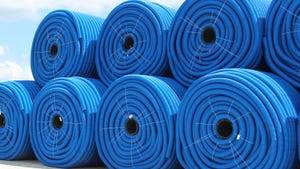Will a carbon fiber supply crunch emerge?
Forecasts for carbon fiber (CF) usage in 2020 vary widely from 136,000 tonnes according to CF supplier SGL Group (Wiesbaden, Germany) to 342,000 tonnes in a best-case scenario painted by Professor Andrew Walker, director of the Northwest Composites Center at the University of Manchester, during the recent JEC Asia Carbon Fiber Forum in Singapore.
July 10, 2012
at the University of Manchester, during the recent JEC Asia Carbon Fiber Forum in Singapore. If the most optimistic scenario is to emerge, CF suppliers will need to get a hurry-on if they have any hope of matching this booming demand, otherwise growth may be restrained by lack of supply.
Through to 2015, around 30,000 tonnes/year of small tow PAN-based CF capacity is due to be added and based on a coefficient of 0.7 to take into account actial plant operational conditions, this translates to just over 67,000 tonnes of output according to Frank Glowacz, technical editor at JEC Composites (Paris, France). Large tow capacity, meanwhile, will almost double from 22,150 tonnes/year capacity in 2011 to 43,200 tonnes/year in 2015, with output of close to 39,000 tonnes.
This 106,000 tonnes/year of output capability seems more than enough to cater to demand for a conservative growth path, given 2015 demand may only be of the order of 47,000 tonnes, but there would be supply concerns if growth tracks the optimistic route given it takes around two years to construct and start up a plant. "If we want to grow the market we need to ensure supply is there and in my view the solution is new entrants," says Walker. "The existing players, particularly the Japanese, are too conservative, and only respond to confirmed projects when adding capacity," says Walker. The share of Japanese suppliers of global CF capacity will decline from 59% in 2011 to 50% in 2015 for small tow PAN-based fibers.
New suppliers are thankfully emerging in the industry such as Alabuga-fiber in the Russian Republic of Tatarstan, which expects to be onstream in 2014, and Kemrock (Vadodara) in India, which started production of industrial CF grades in 2011. The Middle East is also a potential source of CF given its low energy costs. In fact, Saudi Basic Industries Corporation (SABIC, Riyadh) has licensed technology from Montefibre SpA (Milan, Italy) for the production of CF with the initial intent being to construct a 3000-tonnes/yr CF plant at Montefibre's existing acrylic fiber production site in Spain, and in the longer term replicate this effort in Saudi Arabia.
JEC's Glowacz also notes that Qatar has high potential for CF production. Previously, a plan to set up a carbon fiber composites facility for auto components as a joint venture of Qatar Automotive Gateway (Doha) and UK company Prodrive (Oxfordshire) had been announced. —[email protected]
You May Also Like


